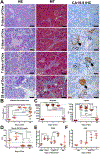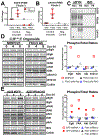The glycan CA19-9 promotes pancreatitis and pancreatic cancer in mice
- PMID: 31221853
- PMCID: PMC6705393
- DOI: 10.1126/science.aaw3145
The glycan CA19-9 promotes pancreatitis and pancreatic cancer in mice
Abstract
Glycosylation alterations are indicative of tissue inflammation and neoplasia, but whether these alterations contribute to disease pathogenesis is largely unknown. To study the role of glycan changes in pancreatic disease, we inducibly expressed human fucosyltransferase 3 and β1,3-galactosyltransferase 5 in mice, reconstituting the glycan sialyl-Lewisa, also known as carbohydrate antigen 19-9 (CA19-9). Notably, CA19-9 expression in mice resulted in rapid and severe pancreatitis with hyperactivation of epidermal growth factor receptor (EGFR) signaling. Mechanistically, CA19-9 modification of the matricellular protein fibulin-3 increased its interaction with EGFR, and blockade of fibulin-3, EGFR ligands, or CA19-9 prevented EGFR hyperactivation in organoids. CA19-9-mediated pancreatitis was reversible and could be suppressed with CA19-9 antibodies. CA19-9 also cooperated with the KrasG12D oncogene to produce aggressive pancreatic cancer. These findings implicate CA19-9 in the etiology of pancreatitis and pancreatic cancer and nominate CA19-9 as a therapeutic target.
Copyright © 2019 The Authors, some rights reserved; exclusive licensee American Association for the Advancement of Science. No claim to original U.S. Government Works.
Conflict of interest statement
Figures






Comment in
-
Hiding in plain sight.Science. 2019 Jun 21;364(6446):1132-1133. doi: 10.1126/science.aax9341. Science. 2019. PMID: 31221844 Free PMC article. No abstract available.
-
Glycosylation alterations in acute pancreatitis and pancreatic cancer: CA19-9 expression is involved in pathogenesis and maybe targeted by therapy.Ann Transl Med. 2019 Dec;7(Suppl 8):S306. doi: 10.21037/atm.2019.10.72. Ann Transl Med. 2019. PMID: 32016025 Free PMC article. No abstract available.
-
CA19-9 as a therapeutic target in pancreatitis.Ann Transl Med. 2019 Dec;7(Suppl 8):S318. doi: 10.21037/atm.2019.09.161. Ann Transl Med. 2019. PMID: 32016036 Free PMC article. No abstract available.
References
-
- Forsmark CE, Vege SS, Wilcox CM, Acute Pancreatitis. N Engl J Med 375, 1972–1981 (2016). - PubMed
-
- Frossard J-L, Steer ML, Pastor CM, Acute pancreatitis. The Lancet 371, 143–152 (2008). - PubMed
-
- van Brummelen SE, Venneman NG, van Erpecum KJ, VanBerge-Henegouwen GP, Acute idiopathic pancreatitis: does it really exist or is it a myth? Scandinavian journal of gastroenterology. Supplement, 117–122 (2003). - PubMed
-
- Lowenfels AB et al., Pancreatitis and the risk of pancreatic cancer. International Pancreatitis Study Group. N Engl J Med 328, 1433–1437 (1993). - PubMed
Publication types
MeSH terms
Substances
Grants and funding
- P20 CA192996/CA/NCI NIH HHS/United States
- R01 CA188134/CA/NCI NIH HHS/United States
- P30 CA016087/CA/NCI NIH HHS/United States
- R01 CA190092/CA/NCI NIH HHS/United States
- P20 CA192994/CA/NCI NIH HHS/United States
- S10 OD018338/OD/NIH HHS/United States
- P50 CA101955/CA/NCI NIH HHS/United States
- P30 CA008748/CA/NCI NIH HHS/United States
- R00 CA204725/CA/NCI NIH HHS/United States
- P50 CA127297/CA/NCI NIH HHS/United States
- U10 CA180944/CA/NCI NIH HHS/United States
- P30 CA045508/CA/NCI NIH HHS/United States
- T32 CA148056/CA/NCI NIH HHS/United States
- P01 CA217798/CA/NCI NIH HHS/United States
- K99 CA204725/CA/NCI NIH HHS/United States
- R50 CA211506/CA/NCI NIH HHS/United States
- U01 CA210240/CA/NCI NIH HHS/United States
- S10 OD010580/OD/NIH HHS/United States
LinkOut - more resources
Full Text Sources
Other Literature Sources
Medical
Molecular Biology Databases
Research Materials
Miscellaneous

